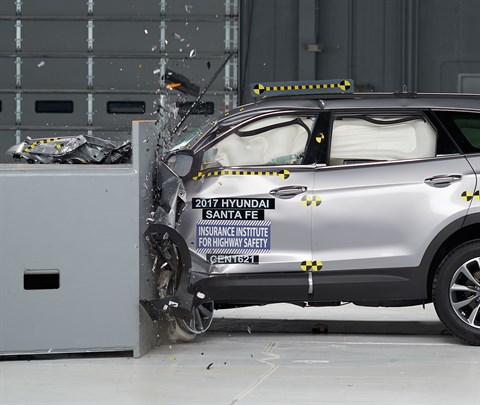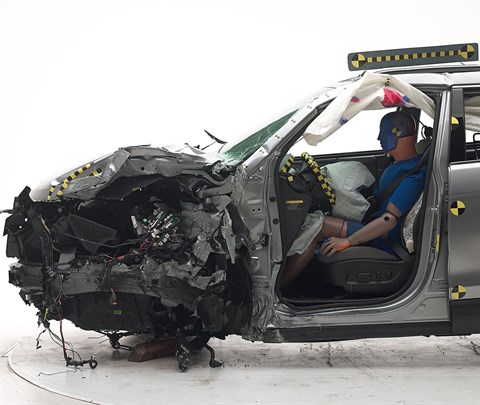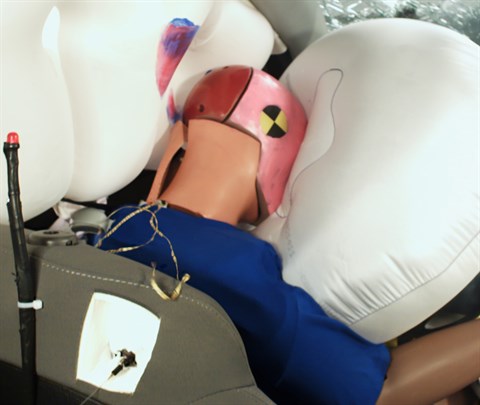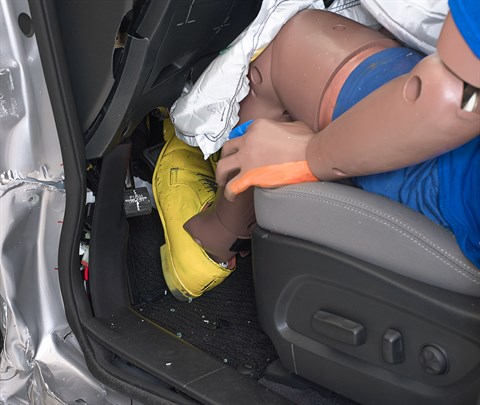Small overlap front: driver-side
Rating applies to 2019 models
Tested vehicle: 2017 Hyundai Santa Fe SE 4-door 4wd
The Hyundai Santa Fe was redesigned for the 2013 model year. There were now two distinct Santa Fe models, a 2-row Sport and a somewhat longer and heavier 3-row Santa Fe.
Beginning with 2017 models, extensive structural reinforcement of the occupant compartment was made to improve occupant protection in small overlap and moderate overlap frontal crashes. Starting with 2017 models built after March 2016, the driver safety belt was modified to further improve occupant protection in driver-side small overlap crashes. (Information about when a specific vehicle was manufactured is on the certification label typically affixed to the car on the driver door or adjacent B-pillar.)
The small overlap ratings on this page apply only to the 3-row Santa Fe, including the 3-row Santa Fe XL, introduced in the 2019 model year with only a new name. The Santa Fe Sport was tested separately, as was the redesigned 2019 2-row Santa Fe.
| Evaluation criteria | Rating |
|---|---|
| Structure and safety cage | |
| Driver injury measures | |
| Head/neck | |
| Chest | |
| Hip/thigh | |
| Lower leg/foot | |
| Driver restraints and dummy kinematics | |

Action shot taken during the driver-side small overlap frontal crash test.

The dummy's position in relation to the door frame, steering wheel, and instrument panel after the crash test indicates that the driver's survival space was maintained well.

The frontal and side curtain airbags worked well together to keep the head from coming close to any stiff structure or outside objects that could cause injury.

The driver's space was maintained well, and risk of injuries to the dummy's legs and feet was low.
Small overlap front: passenger-side
Rating applies to 2019 models
Tested vehicle: 2017 Hyundai Santa Fe SE 4-door 4wd
The Hyundai Santa Fe was redesigned for the 2013 model year. There were now two distinct Santa Fe models, a 2-row Sport and a somewhat longer and heavier 3-row Santa Fe.
Beginning with 2017 models, extensive structural reinforcement of the occupant compartment was made to improve occupant protection in small overlap and moderate overlap frontal crashes.
Passenger-side small overlap frontal ratings are assigned by the Institute based on a test conducted by Hyundai. The ratings on this page apply to both the 3-row Santa Fe (tested) and the Santa Fe Sport through the 2018 model year.
Beginning with the 2019 model year, the 3-row Santa Fe was renamed the Santa Fe XL, and the 2-row Santa Fe Sport was redesigned and renamed the Santa Fe. The 2019 Santa Fe XL therefore shares the ratings on this page, but the redesigned 2019 Santa Fe is rated separately.
| Evaluation criteria | Rating |
|---|---|
| Overall evaluation | |
| Structure and safety cage | |
| Passenger injury measures | |
| Head/neck | |
| Chest | |
| Hip/thigh | |
| Lower leg/foot | |
|
Passenger restraints and dummy kinematics
The dummy’s head contacted the frontal airbag but slid off toward the right side, leaving the head vulnerable to contact with forward structure. The side curtain airbag deployed and has sufficient forward coverage to protect the head from contact with side structure and outside objects. The side torso airbag also deployed. | |
| Driver injury measures | |
| Head/neck | |
| Chest | |
| Hip/thigh | |
| Lower leg/foot | |
| Driver restraints and dummy kinematics | |
Moderate overlap front: original test
Rating applies to 2019 models
Tested vehicle: 2017 Hyundai Santa Fe Sport 2.4 4-door 4wd
The Hyundai Santa Fe Sport was introduced in the 2013 model year, with two rows of seats and distinct from the somewhat longer and heavier Santa Fe, which has three rows of seats. Beginning with 2017 models, extensive structural reinforcement of the occupant compartment was made to improve occupant protection in small overlap and moderate overlap frontal crashes.
Moderate overlap ratings are assigned by the Institute based on a test conducted by Hyundai. Ratings apply to both 2-row and 3-row models through the 2018 model year.
Beginning with the 2019 model year, the 3-row Santa Fe was renamed the Santa Fe XL, and the 2-row Santa Fe Sport was redesigned and renamed the Santa Fe. The 2019 Santa Fe XL therefore shares the ratings on this page, but the redesigned 2019 Santa Fe is rated separately.
| Evaluation criteria | Rating |
|---|---|
| Overall evaluation | |
| Structure and safety cage | |
| Driver injury measures | |
| Head/neck | |
| Chest | |
| Leg/foot, left | |
| Leg/foot, right | |
| Driver restraints and dummy kinematics | |
Side: original test
Rating applies to 2019 models
Tested vehicle: 2013 Hyundai Santa Fe Sport 4-door 2wd with standard front and rear head curtain airbags and standard front seat-mounted torso airbags
The Hyundai Santa Fe was redesigned for the 2013 model year. There were now two distinct Santa Fe models, a 2-row Sport and a somewhat longer and heavier 3-row Santa Fe. Side ratings are assigned by the Institute based on a test conducted by Hyundai. (Note that the vehicle tested was a 2-wheel-drive Sport model, but extra weight was added to the vehicle to increase its curb weight to that of a comparable 4-wheel drive model.) Ratings apply to both 2-row and 3-row models through the 2018 model year.
Beginning with the 2019 model year, the 3-row Santa Fe was renamed the Santa Fe XL, and the 2-row Santa Fe Sport was redesigned and renamed the Santa Fe. The 2019 Santa Fe XL therefore shares the ratings on this page, but the redesigned 2019 Santa Fe is rated separately.
| Evaluation criteria | Rating |
|---|---|
| Overall evaluation | |
| Structure and safety cage | |
| Driver injury measures | |
| Head/neck | |
| Torso | |
| Pelvis/leg | |
| Driver head protection | |
| Rear passenger injury measures | |
| Head/neck | |
| Torso | |
| Pelvis/leg | |
| Rear passenger head protection | |
Roof strength
Rating applies to 2019 models
Tested vehicle: 2013 Hyundai Santa Fe Sport 2.0T 4-door 4wd
Rating applies to both the 2-row Santa Fe Sport (tested) and the somewhat longer and heavier 3-row Santa Fe for the 2013-18 model years. The rating applies only to the 3-row Santa Fe XL for the 2019 model year.
| Overall evaluation | |
|---|---|
| Curb weight | 3,877 lbs |
| Peak force | 16,982 lbs |
| Strength-to-weight ratio | 4.38 |
Head restraints & seats
Seat type: Power leather seats
| Overall evaluation | |
|---|---|
| Dynamic rating | |
| Seat/head restraint geometry |
About the head restraint & seat test
Currently, IIHS tests apply only to front seats.
Headlights
Ratings are given for 2 different headlight variations available on this vehicle.
Trim level(s)
- Limited Ultimate trim equipped with Tech package
| Evaluation criteria | Rating |
|---|---|
| Low-beam headlight type | HID projector |
| High-beam headlight type | HID projector |
| Curve-adaptive? | Yes |
| High-beam assist? | Yes |
|
Overall rating | |
| Distance at which headlights provide at least 5 lux illumination: | |
Low beams
On the straightaway, visibility was good on the right side of the road and fair on the left side. On curves, visibility was good on both right curves, fair on the sharp left curve and inadequate on the gradual left curve.
The low beams never exceeded glare limits.
High beams
On the straightaway, visibility was good on the right side of the road and fair on the left side. On curves, visibility was good in all 4 tests.
High-beam assist compensates for some limitations of this vehicle's low beams on the straightaway and on both left curves.
Trim level(s)
- SE trim
- Limited Ultimate trim
| Evaluation criteria | Rating |
|---|---|
| Low-beam headlight type | Halogen projector |
| High-beam headlight type | Halogen reflector |
| Curve-adaptive? | No |
| High-beam assist? | No |
|
Overall rating | |
| Distance at which headlights provide at least 5 lux illumination: | |
Low beams
On the straightaway, visibility was inadequate on both sides of the road. On curves, visibility was inadequate in all 4 tests.
The low beams never exceeded glare limits.
High beams
On the straightaway, visibility was good on the right side of the road and inadequate on the left side. On curves, visibility was inadequate in all 4 tests.
Front crash prevention: vehicle-to-vehicle
Child seat anchors
Rating applies to 2019 models
| Evaluation criteria | Rating |
|---|---|
| Overall evaluation | |
| Vehicle trim | SE (3-row) |
| Seat type | cloth |
This vehicle has 2 rear seating positions with complete child seat attachment (LATCH) hardware.
It has 1 additional seating position with a tether anchor only.
| Evaluation criteria | Rating |
|---|---|
| Overall evaluation | |
| Vehicle trim | SE (3-row) |
| Seat type | cloth |
| Rating icon | Rating |
|---|---|
| G | Good |
| A | Acceptable |
| M | Marginal |
| P | Poor |
| Seating positions that rely on borrowed lower anchors or have only a tether anchor available are not rated. | |
thether anchor symbol | Tether anchor |
lower anchor symbol | Lower anchors |
| Lower anchor(s) can be borrowed from adjacent positions(s) | |
| No hardware available |
Details by seating position
| Position | Rating |
|---|---|
| 1 | |
| Tether anchor | |
| easy-to-find location | |
| other hardware could be confused for anchor | |
| Lower anchors | |
| too deep in seat | |
| not too much force needed to attach | |
| easy to maneuver around anchors | |
| 2 | |
| Tether anchor | |
| easy-to-find location | |
| other hardware could be confused for anchor | |
| Lower anchors | |
| none available | |
| 3 | |
| Tether anchor | |
| easy-to-find location | |
| other hardware could be confused for anchor | |
| Lower anchors | |
| too deep in seat | |
| not too much force needed to attach | |
| easy to maneuver around anchors |
